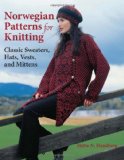Norwegian Patterns for Knitting by Mette N. Handberg, Trafalger Square Books, 2010, 118 pp.
Originally published in Norwegian in 2001.Norwegian Patterns opens with several pages briefly discussing different tips and techniques, including a couple paragraphs on steeks, techniques for binding off, seaming, etc, and a section on correcting problems and mistakes. A lot of it is common sense — probably many of the things that used to be taught in school but apparently, per the author, are no longer.
There are 16 different pattern chapters, each containing at least one or two separate but related patterns. For example, the Coffee Bean chapter has instructions for a jacket with hood, a poncho, mittens and legwarmers. All told you get instructions for at least 8 hats, 7 jackets/coats, 7 pullovers, 3 vests, 1 poncho, 3 mittens, 1 legwarmer, 1 hood, 1 earwarmer, 3 wristwarmers, 1 pair of fingerless gloves, and 1 neckwarmer. When you consider that you can use the charts in other patterns within the book, or in your own designs, the possibilities increase even further.
Some patterns are unisex (Autumn, Wilderness, for example). The Norwegian is sized for men. The patterns highlight many traditional features of Norwegian knitting such as Selbu stars. Though most of the patterns are the cozy, thick, warm sweaters you’d expect, the White and Blue Cotton Tops, delicate textured camisoles with ribbons along the button bands and picot edging, would be great for warmer weather, especially paired with jeans or a cotton skirt.
Stranded knitting, IMHO, is not one of those things that is tremendously difficult to learn. (Of course, it takes practice, for some (like me) more so than others, to get it to look nice, but it’s really not a hard technique.)That said, the skills needed to do these patterns are in the advanced beginner to advanced intermediate range, depending on the pattern (stranding knitting (at least in one pattern with 3 colors in one round), knitting in the round, steeking, charts). All stranded motifs and repeats are charted. I’m a chart junkie, and I have to say the Moose pattern is one of the cutest animal charts, with moose going every which way, I’ve seen.
The instructions are not always explicitly given per what seems to be the norm for us here in the US, but I think a confident intermediate knitter will do fine. This book will appeal to the knitter who likes to make choices for themselves: for example, on one pattern, you’re told: “You can choose the patterning here. You can work the star panel all around, or 1 star at the center….” etc.
Brief overviews on Selbu knitting and knitting from West Norway are given. The pattern chapter in the West Norway section (including the West Norway jacket) feature embroidery.
The photography is lovely, showing both the garments and the landscape well.
US & Norwegian sources for clasps, buttons & Norwegian yarn are listed at the back of the book, which I think is a very nice touch.
***
Trafalgar graciously sent me a copy to give away.
Leave a comment on this post to be entered. Please leave some way of contacting you — either a blog address or your Ravelry name.  I’ll do the random number generator thing to pick a winner & will post the winner on Monday Aug 9th. If I’ve not heard from the winner by midnight PST Aug 11th, I’ll repeat the random number generator.
“Like” Trafalgar Books on Facebook here and leave a comment saying you’ve done so for a second chance to win the book.
If you don’t win a copy, you can purchase one through Amazon by clicking on the book cover above.
I received my review copy from the publisher.




